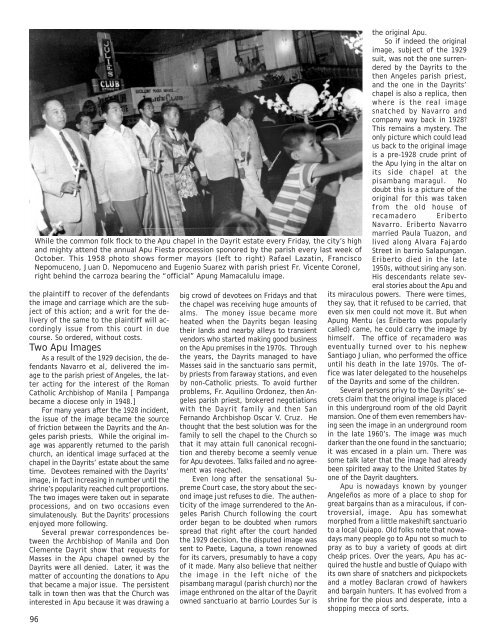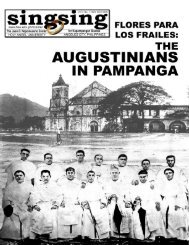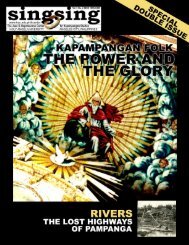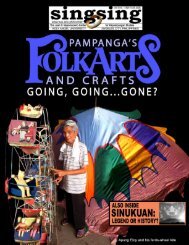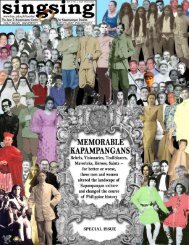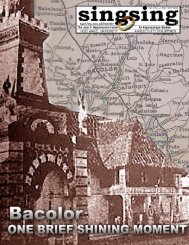Download PDF - Holy Angel University
Download PDF - Holy Angel University
Download PDF - Holy Angel University
You also want an ePaper? Increase the reach of your titles
YUMPU automatically turns print PDFs into web optimized ePapers that Google loves.
While the common folk flock to the Apu chapel in the Dayrit estate every Friday, the city’s high<br />
and mighty attend the annual Apu Fiesta procession sponored by the parish every last week of<br />
October. This 1958 photo shows former mayors (left to right) Rafael Lazatin, Francisco<br />
Nepomuceno, Juan D. Nepomuceno and Eugenio Suarez with parish priest Fr. Vicente Coronel,<br />
right behind the carroza bearing the “official” Apung Mamacalulu image.<br />
the plaintiff to recover of the defendants<br />
the image and carriage which are the subject<br />
of this action; and a writ for the delivery<br />
of the same to the plaintiff will accordingly<br />
issue from this court in due<br />
course. So ordered, without costs.<br />
Two Apu Images<br />
As a result of the 1929 decision, the defendants<br />
Navarro et al, delivered the image<br />
to the parish priest of <strong>Angel</strong>es, the latter<br />
acting for the interest of the Roman<br />
Catholic Archbishop of Manila [ Pampanga<br />
became a diocese only in 1948.]<br />
For many years after the 1928 incident,<br />
the issue of the image became the source<br />
of friction between the Dayrits and the <strong>Angel</strong>es<br />
parish priests. While the original image<br />
was apparently returned to the parish<br />
church, an identical image surfaced at the<br />
chapel in the Dayrits’ estate about the same<br />
time. Devotees remained with the Dayrits’<br />
image, in fact increasing in number until the<br />
shrine’s popularity reached cult proportions.<br />
The two images were taken out in separate<br />
processions, and on two occasions even<br />
simulatenously. But the Dayrits’ processions<br />
enjoyed more following.<br />
Several prewar correspondences between<br />
the Archbishop of Manila and Don<br />
Clemente Dayrit show that requests for<br />
Masses in the Apu chapel owned by the<br />
Dayrits were all denied. Later, it was the<br />
matter of accounting the donations to Apu<br />
that became a major issue. The persistent<br />
talk in town then was that the Church was<br />
interested in Apu because it was drawing a<br />
96<br />
big crowd of devotees on Fridays and that<br />
the chapel was receiving huge amounts of<br />
alms. The money issue became more<br />
heated when the Dayrits began leasing<br />
their lands and nearby alleys to transient<br />
vendors who started making good business<br />
on the Apu premises in the 1970s. Through<br />
the years, the Dayrits managed to have<br />
Masses said in the sanctuario sans permit,<br />
by priests from faraway stations, and even<br />
by non-Catholic priests. To avoid further<br />
problems, Fr. Aquilino Ordonez, then <strong>Angel</strong>es<br />
parish priest, brokered negotiations<br />
with the Dayrit family and then San<br />
Fernando Archbishop Oscar V. Cruz. He<br />
thought that the best solution was for the<br />
family to sell the chapel to the Church so<br />
that it may attain full canonical recognition<br />
and thereby become a seemly venue<br />
for Apu devotees. Talks failed and no agreement<br />
was reached.<br />
Even long after the sensational Supreme<br />
Court case, the story about the second<br />
image just refuses to die. The authenticity<br />
of the image surrendered to the <strong>Angel</strong>es<br />
Parish Church following the court<br />
order began to be doubted when rumors<br />
spread that right after the court handed<br />
the 1929 decision, the disputed image was<br />
sent to Paete, Laguna, a town renowned<br />
for its carvers, presumably to have a copy<br />
of it made. Many also believe that neither<br />
the image in the left niche of the<br />
pisambang maragul (parish church) nor the<br />
image enthroned on the altar of the Dayrit<br />
owned sanctuario at barrio Lourdes Sur is<br />
the original Apu.<br />
So if indeed the original<br />
image, subject of the 1929<br />
suit, was not the one surrendered<br />
by the Dayrits to the<br />
then <strong>Angel</strong>es parish priest,<br />
and the one in the Dayrits’<br />
chapel is also a replica, then<br />
where is the real image<br />
snatched by Navarro and<br />
company way back in 1928?<br />
This remains a mystery. The<br />
only picture which could lead<br />
us back to the original image<br />
is a pre-1928 crude print of<br />
the Apu lying in the altar on<br />
its side chapel at the<br />
pisambang maragul. No<br />
doubt this is a picture of the<br />
original for this was taken<br />
from the old house of<br />
recamadero Eriberto<br />
Navarro. Eriberto Navarro<br />
married Paula Tuazon, and<br />
lived along Alvara Fajardo<br />
Street in barrio Salapungan.<br />
Eriberto died in the late<br />
1950s, without siring any son.<br />
His descendants relate several<br />
stories about the Apu and<br />
its miraculous powers. There were times,<br />
they say, that it refused to be carried, that<br />
even six men could not move it. But when<br />
Apung Mentu (as Eriberto was popularly<br />
called) came, he could carry the image by<br />
himself. The office of recamadero was<br />
eventually turned over to his nephew<br />
Santiago Julian, who performed the office<br />
until his death in the late 1970s. The office<br />
was later delegated to the househelps<br />
of the Dayrits and some of the children.<br />
Several persons privy to the Dayrits’ secrets<br />
claim that the original image is placed<br />
in this underground room of the old Dayrit<br />
mansion. One of them even remembers having<br />
seen the image in an underground room<br />
in the late 1960’s. The image was much<br />
darker than the one found in the sanctuario;<br />
it was encased in a plain urn. There was<br />
some talk later that the image had already<br />
been spirited away to the United States by<br />
one of the Dayrit daughters.<br />
Apu is nowadays known by younger<br />
<strong>Angel</strong>eños as more of a place to shop for<br />
great bargains than as a miraculous, if controversial,<br />
image. Apu has somewhat<br />
morphed from a little makeshift sanctuario<br />
to a local Quiapo. Old folks note that nowadays<br />
many people go to Apu not so much to<br />
pray as to buy a variety of goods at dirt<br />
cheáp prices. Over the years, Apu has acquired<br />
the hustle and bustle of Quiapo with<br />
its own share of snatchers and pickpockets<br />
and a motley Baclaran crowd of hawkers<br />
and bargain hunters. It has evolved from a<br />
shrine for the pious and desperate, into a<br />
shopping mecca of sorts.


